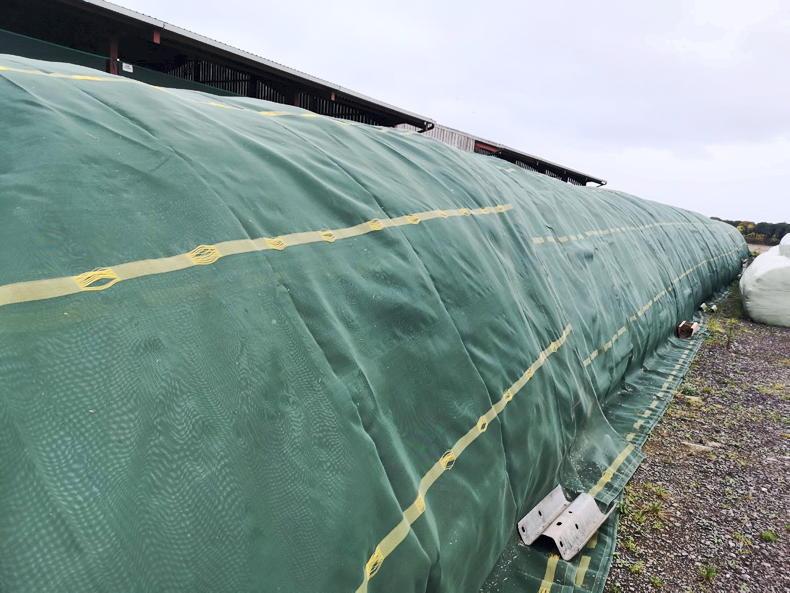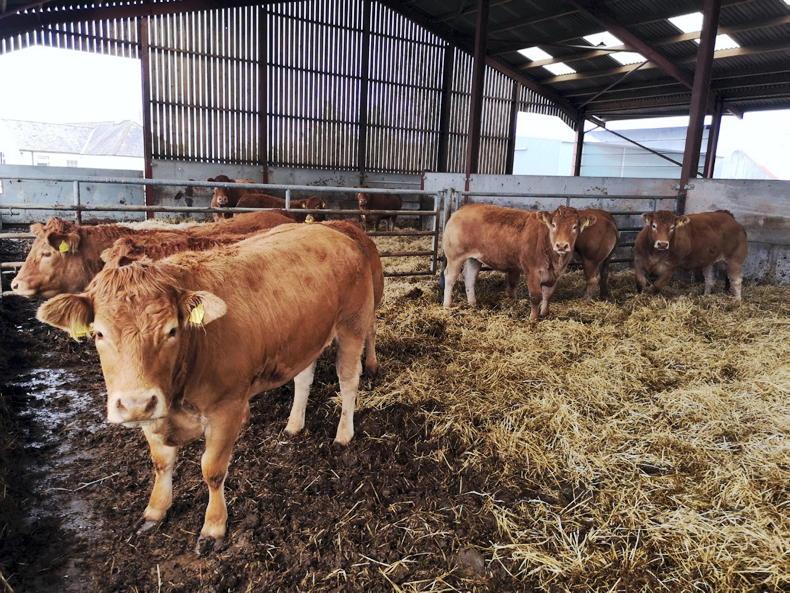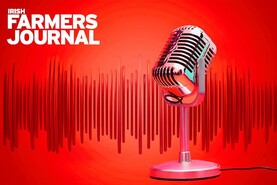Andrew Gammie had just finished housing the last of his cattle when the Farmers Journal visited him this week. Since the start of the programme, Andrew has concentrated on his grazing management and pedigree breeding.
Rotational grazing is now firmly established on the farm with long term plans to increase the area of grass and carry more stock.
Cattle
Autumn calving is nearly finished, with nine cows left to calve. The cows are inside on a diet of silage and draff. Most of the cows calving at this time of year are pedigrees, which gives Andrew a spread of bulls to choose from come sale time.
The remainder of the herd had just been housed, as ground conditions were deteriorating.
Andrew has been reusing the nose flaps over the last couple of years
“I housed the last of them this morning, as I was feeling sorry for them,” said Andrew.
The spring calves have all been fitted with their QuietWean nose flaps, in preparation for weaning next week. Andrew has been reusing the nose flaps over the last couple of years, but thinks he may need to purchase new ones this time, as the reused ones are getting soft and two calves have already lost theirs.
Agbag
At the start of the project, Andrew had silage in both an agbag and in bales. The bag was situated on a field headland behind the yard, and over the course of winter, he found feeding from the bag was difficult, as ground conditions around it deteriorated. By spring, the tracks in and out were very deep.

Ag-bag silage costs in the region of £7/t.
Added to this was the fact that crows had worked along the top of the bag and pecked it, meaning the levels of wastage were high. The experience is still etched in Andrew’s memory and it put him off the agbag for a few years.
However, he is not keen on bales either, due to the higher cost of making the silage, the plastic waste and disposal and the amount of diesel used to break them down. Long-term, he would like to build a silage pit, but with the level of capital investment he has made over the last few years, this will be a couple of years away.
This year, Andrew decided to return to the agbag for first-cut, but do it in such a manner so as to avoid the problems he had last time. Firstly, the bag has been placed in the yard, on a hard standing capped with tar planings.
This will mean less mess when feeding out and less wastage in general, as the ground is a consistent level all the way back.
Secondly, he has purchased a heavy-duty mesh to sit on top of the bag. This will both protect it from bird damage and reduce any wind shear across the bag. Depending on tonnage and location, the agbag costs in the region of £7/t.
Unfortunately, due to weather conditions at the time, first-cut was taken three weeks later than planned
During feedout, the loader bucket is kept just off the ground and skims the silage from the cover in. Once this is cleared, the sides are pulled in and picked up. After that, the cover is trimmed back and the operation is repeated. It does require a little graiping to clear up as it goes, but in general, it is a good compromise on building a silage pit in the short-term.
Unfortunately, due to weather conditions at the time, first-cut was taken three weeks later than planned, meaning that while energy was still above 11ME, crude protein was below 10%.
This is frustrating for Andrew and he will need to feed more protein this winter.
However, he has bought draff from his local distillery to take care of this, along with a high protein molasses. Second-cut was baled six weeks after the first and is a much better silage.
Pedigree progress
Despite COVID-19 cancelling shows and sales for much of the year, Andrew has still had a good spell with his pedigree animals. He even tried using Facebook to sell a bull.
“We got a professional in to video and photograph a bull for selling,” said Andrew.

Andrew Gammie's Limousin heifers.
“A lot of breeders are doing this, as so many cattle are being sold online this year. The pictures and video went up on our Facebook page at lunchtime – by 2pm we had a sale and half the money was in the bank by 5pm.”
The bull is heading to Ireland
As has been mentioned in previous articles, Andrew is concentrating on a few key pedigree lines, and is doing quite a lot of embryo transfer work to facilitate this. This requires a supply of good maternal animals that have a clean bill of health to act as embryo recipients.

Andrew has imported a dozen Fleckvieh heifers from Germany for pedigree embryo.
Recently, Andrew sourced and imported a dozen Fleckvieh heifers from Germany. For their first calf, they will be embryo recipients and will then go on to join the commercial herd for the rest of their time on-farm.
The reason Andrew has chosen Fleckvieh is they are genetically similar to the Simmental breed, but are more focused on milk production as opposed to terminal beef traits.
This will give Andrew better milk production from his cows, without bringing dairy-type cows in and out.
Future on the farm
Looking to the future, Andrew sees a continuation of his current path. This would likely see less of the farm in an arable rotation and more grass sown.
“In time, I could put the whole place into grass for cattle,” said Andrew. Being surrounded by prime arable land, his farm will stick out. But as shown by his grassland and pedigree changes, he isn’t afraid to follow his own path.
Andrew Gammie had just finished housing the last of his cattle when the Farmers Journal visited him this week. Since the start of the programme, Andrew has concentrated on his grazing management and pedigree breeding.
Rotational grazing is now firmly established on the farm with long term plans to increase the area of grass and carry more stock.
Cattle
Autumn calving is nearly finished, with nine cows left to calve. The cows are inside on a diet of silage and draff. Most of the cows calving at this time of year are pedigrees, which gives Andrew a spread of bulls to choose from come sale time.
The remainder of the herd had just been housed, as ground conditions were deteriorating.
Andrew has been reusing the nose flaps over the last couple of years
“I housed the last of them this morning, as I was feeling sorry for them,” said Andrew.
The spring calves have all been fitted with their QuietWean nose flaps, in preparation for weaning next week. Andrew has been reusing the nose flaps over the last couple of years, but thinks he may need to purchase new ones this time, as the reused ones are getting soft and two calves have already lost theirs.
Agbag
At the start of the project, Andrew had silage in both an agbag and in bales. The bag was situated on a field headland behind the yard, and over the course of winter, he found feeding from the bag was difficult, as ground conditions around it deteriorated. By spring, the tracks in and out were very deep.

Ag-bag silage costs in the region of £7/t.
Added to this was the fact that crows had worked along the top of the bag and pecked it, meaning the levels of wastage were high. The experience is still etched in Andrew’s memory and it put him off the agbag for a few years.
However, he is not keen on bales either, due to the higher cost of making the silage, the plastic waste and disposal and the amount of diesel used to break them down. Long-term, he would like to build a silage pit, but with the level of capital investment he has made over the last few years, this will be a couple of years away.
This year, Andrew decided to return to the agbag for first-cut, but do it in such a manner so as to avoid the problems he had last time. Firstly, the bag has been placed in the yard, on a hard standing capped with tar planings.
This will mean less mess when feeding out and less wastage in general, as the ground is a consistent level all the way back.
Secondly, he has purchased a heavy-duty mesh to sit on top of the bag. This will both protect it from bird damage and reduce any wind shear across the bag. Depending on tonnage and location, the agbag costs in the region of £7/t.
Unfortunately, due to weather conditions at the time, first-cut was taken three weeks later than planned
During feedout, the loader bucket is kept just off the ground and skims the silage from the cover in. Once this is cleared, the sides are pulled in and picked up. After that, the cover is trimmed back and the operation is repeated. It does require a little graiping to clear up as it goes, but in general, it is a good compromise on building a silage pit in the short-term.
Unfortunately, due to weather conditions at the time, first-cut was taken three weeks later than planned, meaning that while energy was still above 11ME, crude protein was below 10%.
This is frustrating for Andrew and he will need to feed more protein this winter.
However, he has bought draff from his local distillery to take care of this, along with a high protein molasses. Second-cut was baled six weeks after the first and is a much better silage.
Pedigree progress
Despite COVID-19 cancelling shows and sales for much of the year, Andrew has still had a good spell with his pedigree animals. He even tried using Facebook to sell a bull.
“We got a professional in to video and photograph a bull for selling,” said Andrew.

Andrew Gammie's Limousin heifers.
“A lot of breeders are doing this, as so many cattle are being sold online this year. The pictures and video went up on our Facebook page at lunchtime – by 2pm we had a sale and half the money was in the bank by 5pm.”
The bull is heading to Ireland
As has been mentioned in previous articles, Andrew is concentrating on a few key pedigree lines, and is doing quite a lot of embryo transfer work to facilitate this. This requires a supply of good maternal animals that have a clean bill of health to act as embryo recipients.

Andrew has imported a dozen Fleckvieh heifers from Germany for pedigree embryo.
Recently, Andrew sourced and imported a dozen Fleckvieh heifers from Germany. For their first calf, they will be embryo recipients and will then go on to join the commercial herd for the rest of their time on-farm.
The reason Andrew has chosen Fleckvieh is they are genetically similar to the Simmental breed, but are more focused on milk production as opposed to terminal beef traits.
This will give Andrew better milk production from his cows, without bringing dairy-type cows in and out.
Future on the farm
Looking to the future, Andrew sees a continuation of his current path. This would likely see less of the farm in an arable rotation and more grass sown.
“In time, I could put the whole place into grass for cattle,” said Andrew. Being surrounded by prime arable land, his farm will stick out. But as shown by his grassland and pedigree changes, he isn’t afraid to follow his own path.









 This is a subscriber-only article
This is a subscriber-only article










SHARING OPTIONS: